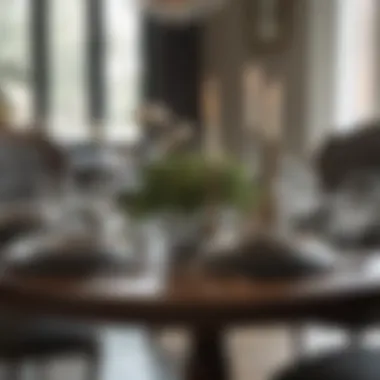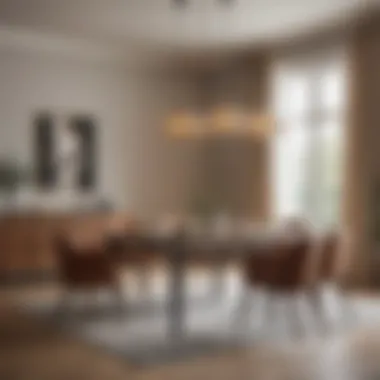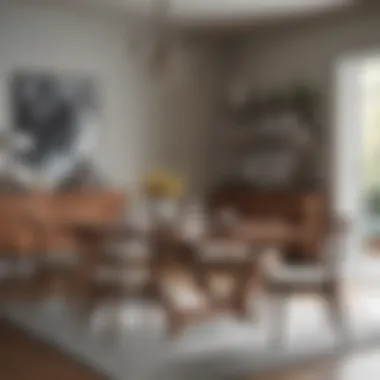Dining Table Sets and Hutches in Home Design


Intro
When it comes to furnishing dining spaces, the marriage of dining table sets and hutches becomes pivotal in establishing both aesthetic appeal and practical functionality. This intersection serves not just as a meal gathering spot but also as a vital part of a home’s overall design narrative. Exploring how these elements complement each other reveals a deeper understanding of interior design choices, leading homeowners and enthusiasts alike to create inviting and harmonious spaces.
The appeal of a well-set dining area is undeniable; it's where families gather to share experiences and create memories. Thus, choosing the right dining table set paired with a stylish hutch can elevate functionality while being visually appealing. With the myriad of styles and materials available, the decision-making process can often feel overwhelming. Nonetheless, this journey through the intricacies of dining furniture will help clarify your path toward creating a stunning dining environment that reflects your personal taste.
As we venture forward, we will delve into the various furniture styles and emerging trends that are shaping the landscape in 2023, while also offering practical tips for selecting pieces that truly enhance your space.
Understanding Dining Table Sets
Dining table sets represent more than just functional furniture; they're a centerpiece for social gatherings and an expression of personal style. The table serves as a backdrop for family meals, festive celebrations, or casual conversations over coffee. In this article, the philosophy behind choosing the right dining table set will be examined, considering style, material, and practical needs.
A well-chosen dining set creates a platform to enhance aesthetic appeal and functionality, bridging the gap between comfort and design. Therefore, understanding various elements—such as types of dining tables, the materials used, and influences like room size or budget—plays a key role in establishing the perfect dining environment.
Definition and Purpose
Dining table sets typically include a table and accompanying chairs, designed for the specific function of dining. They are not only about eating but also serve as a gathering spot for conversations, games, and homework. Choosing the right set involves understanding personal needs and the available space in which it fits. A table can evoke a sense of community, making it an essential aspect of home life.
Different Types of Dining Table Sets
- Standard Dining Sets: A standard dining set is characterized by its straightforward design, usually comprising a rectangular or oval table with a defined number of chairs. Its key benefit is versatility—these sets fit in various settings, from modern apartments to classic homes. A unique feature of standard sets is their often modular nature, allowing for flexibility in placement. However, they may not suit larger gatherings unless complemented with additional seating.
- Expandable Dining Sets: Expandable sets bring a level of practicality that appeals to many homeowners. With a mechanism to increase the table’s size, it's an ideal solution for hosting guests. The key characteristic lies in its transforming ability, making these sets invaluable for those who value versatility. While expandable tables are an excellent investment, they may require some maintenance in regards to the mechanisms involved, and can be a bit bulky when in their non-expanded form.
- Counter-Height Sets: These sets bring a touch of casual charm, often found in dining spaces that emphasize a relaxed atmosphere. The key characteristic here is the height; counter-height tables and chairs tend to be taller than standard. This style typically fosters intimate conversations close to the bar or kitchen. Nevertheless, their unique height can make it challenging for those with mobility issues.
- Round vs. Rectangular: The choice between round and rectangular tables can significantly affect the dining space. Round tables encourage conversation with their intimate design, making them visually appealing for smaller areas. In contrast, rectangular tables are great for larger gatherings, providing more surface area. Each option has unique advantages, with round tables offering a welcoming ambiance, while rectangular tables often feature a more formal aesthetic.
The Role of Hutches in Dining Spaces
Hutches contribute significantly to the warmth and functionality of dining areas. They are not mere accessories; they stand as the cornerstone of dining space organization and style. In this article, we'll examine hutches as multipurpose units that not only serve practical needs but also play a pivotal role in enhancing the overall aesthetic appeal of dining settings.
Definition and Main Functions
A hutch is essentially a type of cabinet with shelving above, designed primarily for dining spaces. Its main functions fall into two broad categories: storage and display.
- Storage: Hutches provide ample space to store dinnerware, glassware, and other dining essentials. Having these items neatly tucked away yet easily accessible makes meal preparations and hosting gatherings smoother.
- Display: Beyond functionality, hutches serve as a platform to exhibit beautiful china or collectibles, fostering an inviting atmosphere. This not only adds character to the room but can also be a conversation starter at dinner parties.
Varieties of Hutches
Understanding the different types of hutches can guide homeowners in making informed decisions that align with their needs and preferences. Here’s a look at this diversity:
Open-Display Hutches
Open-display hutches present dinnerware and decorative pieces without barriers, showcasing them to guests. The inviting aspect of open shelves allows for easy visibility and accessibility. However, it is essential to curate the items displayed carefully, as clutter could become visually overwhelming. This style particularly suits casual dining areas, inviting a relaxed and friendly vibe.
Enclosed Hutches
Enclosed hutches come with glass or wooden doors, providing an element of protection for the items stored inside. They help keep dust at bay, making them ideal for valuable dinnerware that’s used less frequently. Enclosed hutches offer a sense of elegance and a polished look that can elevate the dining experience. The downside might be limited visibility of displayed items, but this often contributes to a more organized appearance.
Sideboards
Sideboards, while often confused with hutches, serve somewhat different functions. Primarily serving as serving stations, sideboards provide horizontal surfaces for placing dishes during meals. Many models include drawers or cabinets to store linens or flatware and can be paired with a mirror for added depth in a dining room. Their versatility makes them suitable for both traditional and modern settings.
Buffets


Buffets resemble sideboards but are generally larger and incorporated into formal dining settings. They provide significant surface area for food presentation, allowing hosts to outline a lavish spread during parties. Buffets often feature elegant finishes, making them a focal point in dining areas. However, when overloaded, they can detract from other decor, so careful arrangement is key.
Material and Design Elements
Selecting the right materials and design elements will enhance the effectiveness of hutches in a dining space.
Wood Finishes
Wood finishes can bring warmth and texture to a dining room. Choices range from bold oak to soft pine, each lending its own character. Darker finishes often convey a traditional feel, while lighter woods may harmonize with contemporary designs. The choice of wood also determines durability and maintenance requirements. For instance, while hardwoods offer longevity, they can require more upkeep than softer woods.
Glass Panels
Glass panels allow light to filter through a hutch, adding a sense of openness. Models that incorporate glass shelving can create striking displays. However, it's crucial to consider that glass surfaces require regular cleaning to maintain their clarity and shine. This style offers a modern twist, often appealing to minimalists who prefer clean lines.
Decorative Moldings
Decorative moldings can elevate a hutch’s profile, adding an air of sophistication. Molding styles vary widely—some evoke classic architecture, while others lean toward a sleek, modern aesthetic. Such embellishments can instill a sense of craftsmanship. On the flip side, over-embellishing might lead to a crowded appearance, so balance should be the guiding principle.
Combining Hutches with Dining Table Sets
For a cohesive dining space, harmonizing hutches with dining table sets is vital. Here are elements to evaluate:
Size and Proportion
The size of a hutch should correlate with the dimensions of the dining table. An oversized hutch can overpower a small dining area, while a dainty hutch might disappear next to a grand table. Maintaining proportion helps create a balanced environment that feels complete without being cluttered.
Color Coordination
Color coordination can tie together disparate elements in a room. Opting for hues that complement or match a dining table enhances visual appeal. For example, a deep mahogany table pairs well with a similarly finished hutch, creating a unified look. However, introducing contrasting colors can add intrigue and highlight specific furnishings.
Complementary Styles
Lastly, the style of the hutch should complement that of the dining table. A rustic table pairs beautifully with a country-style hutch, whereas a sleek, modern table can find its match in a contemporary hutch design. Keeping a consistent style guards against visual dissonance while ensuring elegance in the overall design.
Practical Uses for Hutches
Understanding the practical applications of hutches contributes to making the most of these versatile pieces of furniture.
Storage for Dinnerware
Storing dinnerware in a hutch creates efficiency in a distanced, often bustling dining area. Items can be easily accessed right before meals start, minimizing the risk of delays. With careful organization, it's possible to segregate daily use items from special occasion dishware, creating a system that resonates with various dining needs.
Display of Decorative Items
While function is necessary, aesthetics also matter. A hutch can serve as a display for family heirlooms, awards, or travel mementos. By curating these items thoughtfully, it connects personal history to the dining experience, making it richer and more inviting. An overcrowded hutch, however, can diminish this personal touch and lead to a cluttered appearance.
Convenience for Serving
Finally, a hutch provides convenient space to set out items during meal serving. When a gathering reaches its peak, the quick access to serving platters and glassware transforms dining from functional to enjoyable. Designed with ease of use in mind, many huts come with additional counter space where food can be laid out for hosting, contributing to a relaxed environment.


Designing Harmonious Spaces
Creating a dining area that resonates with elegence and functionality is key to any well-designed home. The intersection of dining table sets and hutches offers significant opportunities for enhancing the visual and experiential quality of the dining area. While choosing these elements, there are some crucial factors to keep in mind. Harmony in design not only makes the space visually appealing but also invites warmth and encourages togetherness among family and friends.
Establishing a Cohesive Look
Achieving a cohesive look starts with understanding your style preferences. When choosing a dining table set and hutch, it’s essential that they complement each other. This means matching styles, colors, and finishes. For instance, if you have a rustic farmhouse table, pairing it with a modern, sleek hutch might upset the balance in the room. Additionally, bringing in elements from other parts of the home can enhance continuity. A cohesive visual language makes the room inviting rather than jarring.
Color Schemes and Textures
Harmonizing color schemes can transform a dining space. Here are a couple of ways to think about it:
Monochromatic vs. Contrast
When people talk about monochromatic schemes, they often refer to a single color in various shades. This choice can create a serene and unified atmosphere. Choosing a rich navy hutch with a lighter blue dining table might not sound exciting, but the results can be stunning. It offers a subtle elegance that whispers sophistication without shouting for attention.
In contrast, using striking colors creates a visual quilt that catches the eyes. Think of a bright cherry-red table paired with a subtle cream hutch. The boldness definitely adds a lively feel to the room, making it an enjoyable space for gatherings. However, there’s a risk of overwhelming the senses if colors clash or feel out of place.
Use of Fabrics and Patterns
Fabrics add texture and warmth to a space, which is especially wonderful when it comes to dining areas. Using plush linens or textured cushions can significantly enhance comfort for guests. Patterns, on the other hand, bring a playful aspect to the room. Floral patterns on chair upholstery can dance delightfully with a solid wood table.
However, too many patterns may feel chaotic, so a careful balance is key. For example, using patterned seat covers with a straightforward table can create an inviting space without overdoing it.
Creating Flow in Open Areas
Flow is about more than just layout; it’s about how you navigate a space. Carefully place your dining table and hutch to encourage movement. If you can easily pass between rooms without bumping into furniture, you’ve created a successful layout. The table should ideally align with the hutch in terms of height to ensure they connect visually, making the area feel open and welcoming.
Combining Materials Intelligently
Mixing Metal and Wood
Combining materials can add layers of depth to your dining space. Mixing metal and wood is a popular strategy that infuses a modern twist into classic designs. Imagine a sturdy wooden dining table with metal accents in its legs; this combination brings warmth and an industrial feel. The metal gives contemporary vibes, while the wood retains the comfort of classic styles.
It’s important, however, to balance the two. If one material overpowers, it may disrupt harmony and distract from the overall design.
Playing with Finish Variations
Variations in finishes can breathe life into your dining area. A natural wood table paired with a high-gloss hutch can create an interesting yet balanced dialogue between rustic and modern styles. The glossy finish can reflect light beautifully, adding luminosity to the space without creating an environment that feels too sterile. That said, the challenge lies in ensuring that varying finishes do not clash, which can throw the eye off.
Incorporating Lighting
Types of Dining Area Lighting
Effective lighting is crucial in setting the mood. From chandeliers to pendant lights, this element greatly impacts the dining experience. A well-placed chandelier can draw attention to your dining table while also providing enough light to enhance function. Dimmer switches enhance flexibility, allowing the brightness to suit various occasions.
Light Features that Enhance Mood
Incorporating soft, ambient lighting, particularly around a dining table, can change the entire feel of the area. Features such as adjustable LED lights or warm light bulbs can drastically shift the ambiance from a lively meal to an intimate gathering. The key is finding that sweet spot between practicality and atmosphere, ensuring that lighting complements both the hutch and the dining set without overpowering the entire area.


Maintaining and Caring for Dining Sets and Hutches
Caring for dining sets and hutches is not just an afterthought; it’s central to preserving the beauty and functionality of these crucial home elements. Regular maintenance extends their lifespan and keeps them looking as good as new. An unkempt table set or a hutch can become the weak link in an otherwise well-decorated dining space.
Beyond aesthetics, proper care often has practical implications. For instance, a well-maintained dining table can prevent accidents caused by scratches or damage that might make the surface unsteady. Not to mention, freeing your hutch from dust and grime can ensure your decor and dinnerware remain inviting for every gathering.
Regular Cleaning Practices
Creating a regular cleaning schedule is essential in maintaining the integrity of dining sets and hutches. This includes sweeping away crumbs, wiping down surfaces, and periodically giving a thorough clean to remove built-up grime. It's typically best to avoid harsh chemicals, especially on wood and glass, opting instead for gentle, pH-balanced cleaners.
Always keep a soft cloth handy for quick clean-ups—microfiber cloths are particularly effective. They’re gentle and can trap dust and dirt without scratching surfaces. Getting into the habit of cleaning spills immediately also goes a long way in preventing stains and damage.
Preventive Measures Against Damage
Preventive measures can save you both time and money in the long run. Being proactive about your furniture’s care can help mitigate issues before they become more extensive problems.
Use of Coasters and Placemats
Using coasters and placemats is a straightforward yet impactful preventive measure against any potential damage from heat or moisture. Coasters act as a barrier between hot or cold drinks and the surface of your dining table, minimizing the risk of rings or heat marks.
Placemats not only protect your table but they add an extra layer of design flair to your dining experience. They can be found in various styles, complementing the overall theme of your space. Choosing high-quality, easy-to-clean options can make this a beneficial practice. In fact, incorporating coasters and placemats can enhance both usability and aesthetic appeal.
Routine Inspections for Wear
Routine inspections are another key aspect of furniture maintenance. Regularly checking for any signs of wear allows you to catch potential problems before they escalate. This means looking for scratches, loose fittings, or chips in the finish. It’s a practice that encourages you to be mindful of how your dining area is used daily.
Having a furniture care kit on hand can make inspections easier. It should include items like a small touch-up pen for scratches or a buffing cloth for polishing. This kind of prep ensures you're always ready to address wear and tear promptly.
Seasonal Care Tips
Seasonal care considerations also play a crucial role, particularly in ensuring longevity for your dining sets and hutches. Keeping up with changing conditions can make all the difference in preserving their beauty.
Humidity Control for Wood
Wood furniture is especially sensitive to humidity levels in your home. Too much moisture can cause wood to swell, crack, or warp. Keeping humidity levels balanced—ideally around 30% to 50%—is vital. A dehumidifier or humidifier can assist with this, depending on your environment.
Moreover, placing wooden furniture away from direct sunlight can help protect it from fading or excessive drying, so it’s worth considering the placement of your dining sets and hutches during the changing seasons.
Cleaning Glass Surfaces
Cleaning glass surfaces frequently can add to the upkeep of hutches and tables that features glass elements. Using a specific glass cleaner along with a soft lint-free cloth helps prevent streaking. For those stubborn smudges, a vinegar-water solution can work wonders. Importantly, always clean glass with care to avoid chipping or scratching, especially if the glass is framed in wood.
By fostering these maintenance practices, homeowners can ensure their dining sets and hutches continue to serve as central pieces in their dining spaces—both functional and beautiful. Taking these steps not only protects your investment but elevates the overall atmosphere of your home.
End
The exploration of dining table sets and hutches within the realm of interior design unravels a tapestry of choices that shape not just aesthetics, but also functionality and atmosphere in the dining space. Understanding how these two components intersect can greatly enhance the dining experience, making it not just about meals, but about creating memory-filled moments within a well-coordinated environment.
It's crucial for homeowners and designers to grasp how dining table sets serve as the centerpiece for gatherings, while hutches, with their dual roles of storage and display, complement the style and utility of the setting. This relationship isn't merely about placing furniture in proximity; it's about harmonizing elements that speak to the personal narrative and preferences of the inhabitants.
Considerations such as size, material compatibility, and design coherence must guide your selections. A hutch merely tossed against a wall may as well be a shadow on the dining experience. When thoughtfully integrated, these pieces tell a story and create a sense of warmth. They echo back to the essence of home, which insists on welcoming and sharing.
In summary, achieving elegance in dining spaces goes far beyond mere arrangement. It's about deliberating over each choice — from the table's surface style to the hutch's wood finish — to create a seamless flow between the two. Closer inspection reveals the importance of craftsmanship, color coordination, and adaptability to seasonal décor, thus making dining spaces not just zones for eating, but arenas for social engagement, creativity, and aesthetics.
"In the dining area, beauty meets functionality, allowing inhabitants to engage with their environment in profound ways."
Elevating dining elegance through informed choices elevates the everyday meal into a cherished ritual, confirming that the interactions we cultivate in our homes are fundamentally affected by our attention to the surroundings we design.







